John “Rocky” Barrett
Tribal Chairman
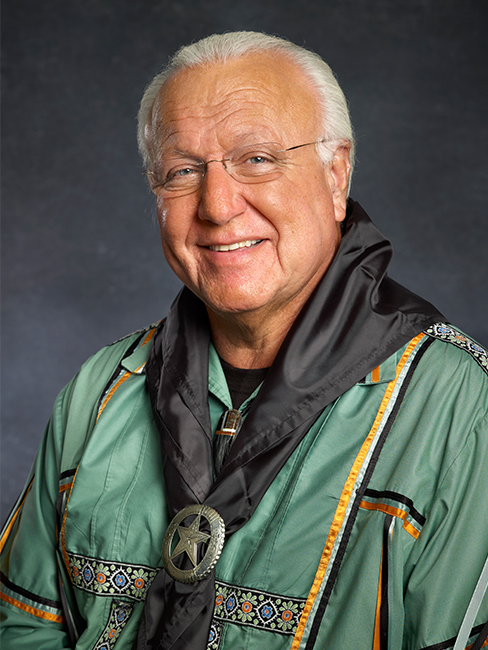
Bozho nikan (Hello friend),
History of the CPN seal
The first Citizen Potawatomi Nation Tribal seal was created by Secretary/Treasurer Beverly Hughes in the 1970s. It was a black line circle with “Great Seal of the Citizen Band of Potawatomi Indians of Oklahoma” inside the edge and featured a crossed Cherrokee style pipe and tomahawk over a fire with three logs. Beneath it was an oak leaf over a vine symbol. When the Tribe changed its name to “Citizen Potawatomi Nation” by constitutional amendment in 1996, a new seal was needed. I created the drawing and design. The name change was due to the declaration of our inherent tribal sovereignty by tribal law and the extension of voting rights by absentee ballot to all Citizen Potawatomi in or outside of Oklahoma. The name change to “Nation” also corrected the inference of non-tribal status implied in the word “band,” a word that usually describes an offshoot of another tribe.
Given the profound changes in Tribal governmental philosophy, the decision was made to maintain as much of the old seal as possible while adding elements of Potawatomi traditional symbolism to the new Tribal seal. I originally drew it in 1995 in pen and ink and colored pencil while the name change was pending. The design began to vary slightly over the years with the graphic adaptations of commercial printers, once
even changing the number of logs in the fire, an essential element. This was corrected in 2003.
The Circle
The Tribal seal is a red circle symbolizing the Great Circle of Life — Gzhemnedo or Mamogosnan’s (God’s) great pattern for all things. All of God’s creations move clockwise like the sun and the moon through their existence in a great circle from light to dark, living world to spirit world and back. Man comes from the dark inside his mother to the light, loves his life and returns to the dark. His life force — his “fire” — the energy that made his cells divide and blood flow, returns undiminished to Sugamukwe (Mother Earth) and emerges into the light in the life force of other living things. A tree seed sprouts in the soil, emerges into the sun, lives its life, falls and decays into the soil again to nourish another seed. Even the rocks emerge as mountains pushed up from the depths to the surface by geologic pressure. They weather into boulders, then rocks, then sand, then dissolve into layered deposits, which create depths forming pressure and heat, and another mountain pushes up. Every beginning has an end. Every end is a beginning.
The red in the circle is the color of Wetchnowkwek, the South, symbolizing the direction of procreation, the women’s direction. All living things are born of a mother. South is the direction of KehTahMah GehNinGahWin, the Spirit of Compassion, the core strength God gave women for the rigors of motherhood and one of the four Spirits that God intended for all mankind to exhibit in each individual’s character. The existence of our Tribe is based on our union of families, related by our red blood for the purpose of caring for our own kin, especially those who cannot care for themselves in some way or another — infant, child, elder, sick or afflicted. Compassion must be given with generosity, shaped by courage and guided by wisdom.
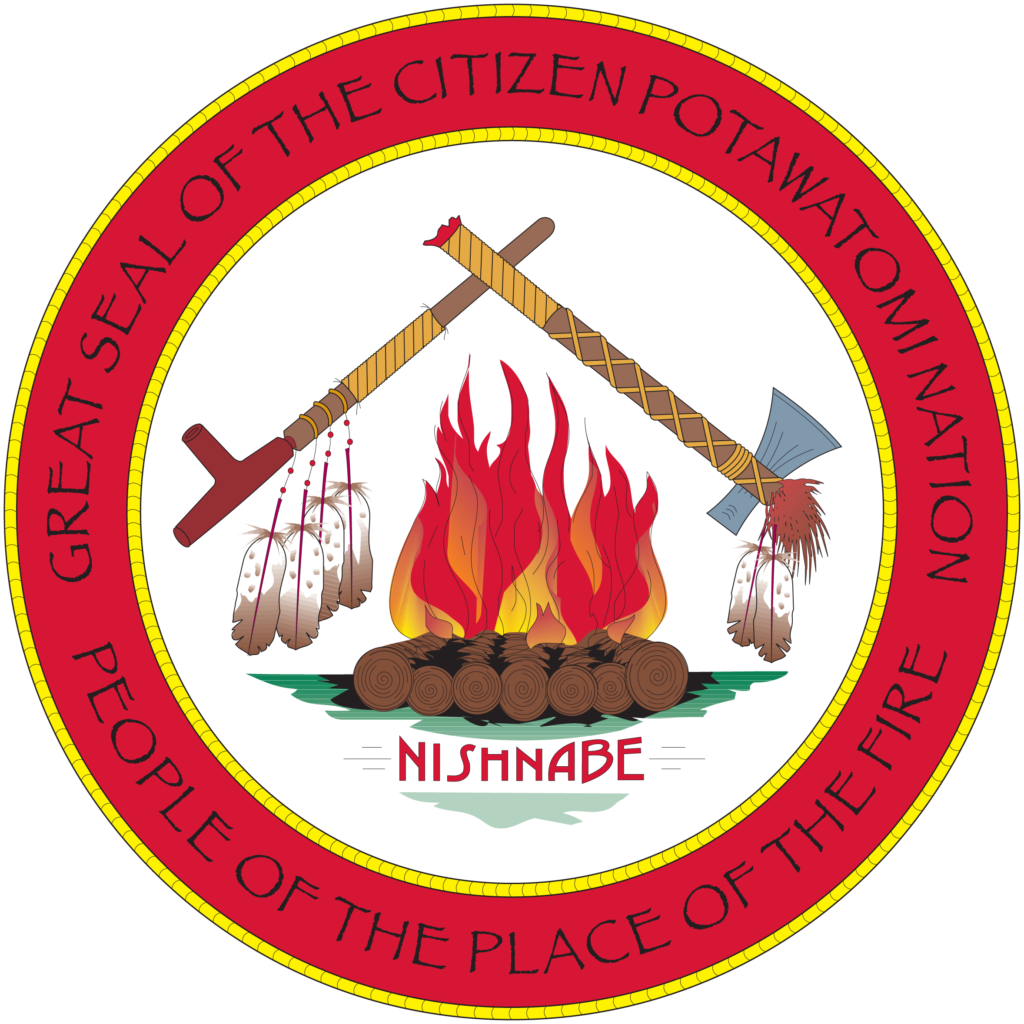
The Border
The red border is surrounded on both edges by a yellow rope. Yellow is the color of WetchMoKuk, the East, the direction of BwaKahWin, the Spirit of Wisdom. The first wisdom was the original man’s knowledge of God’s Great Plan in the Circle of Life: The life of one living thing is related to the life of all other living things. Wisdom is rooted in the realization that the lessons of Mother Earth — Her creatures and features, and the heavens, the Sun, Moon and stars — are the source of the knowledge of life. The “two-leggeds,” mankind, are the only of God’s creatures given the knowledge to choose between the good and evil within human nature. All other creatures function by instinct. Knowledge applied with compassion, courage and generosity becomes wisdom. Wisdom should surround the decisions of our Tribal government.
The Declaration
The words written in black inside the red border are “Great Seal of the Citizen Potawatomi Nation,” declaring that we are a Nation of unique people with the sovereign power of self-governance since time immemorial. Our government is recognized by more government-to-government treaties with the United States than any other Tribe as well as by treaties with France and Great Britain before the existence of the United States. We are called the Citizen Potawatomi Nation in recognition of our decision to take United States citizenship as a body in 1861, the first Tribe to do so in U.S. history. The letters are in the color black, for the color of WetchBahKezMok, the West. The Spirit of the West is WehDahSahWin — Courage. It took incredible courage for our forefathers to have survived and kept us intact as a Tribe through war, disease and deprivation. Courage must be tempered with compassion and summoned with wisdom.
The Field
The field of the seal is white. White is the color of WetchKehSimYok, the North. It is the direction of MeanGoWin — the Spirit of Generosity. Underlying all of the Great Seal is the color white, as giving must be the motive underlying Tribal governance. Giving is always in two directions — as you give, so shall you receive. As you receive, so should you give. Giving then makes a circle.
North is the source of water, the most precious gift Mother Earth gives to all living things, her lifeblood. The purifying snows of the North melt and renew the waters of our continent, Turtle Island, evaporate, form clouds and fall again, endlessly.
The Shelter
The top of the field of the Great Seal has a pwagen (pipe) crossed with a WahGakWaDoan (tomahawk) to form the shape of a roof or shelter over the fire. In peace or war, good times or bad, the Tribe must shelter and protect its people.
The pwagen is a prayer instrument. Its pipestone bowl holds the burning tobacco from which rises prayer smoke, a visible manifestation of our prayers to the Creator. The wooden stem is the human connection to the fire in the bowl. The bowl and stem are only joined for the Seven Prayers when we communicate with God as we smoke the pipe. The pwagen on the Great Seal means we pray for the good of our people and believe in the power of prayer. The pwagen carries four Eagle feathers, symbolizing the Four Directions and the four Spirits that God intended mankind to carry in his character.
The tomahawk symbolizes our commitment to defend our Tribe and our history of doing so. It is positioned with the blade up showing we are not at war. The tomahawk carries two Eagle feathers, symbolizing the two inner natures and the two genders of mankind, and the two halves of existence in the Great Circle of Life — the living world and the spirit world — the light and the dark.
Kno (the Eagle) is God’s messenger that calls out to the Creator that the faithful still inhabit Mother Earth when it sees prayer smoke rising from the fires of the Nishnabe. Each day before the full dawn, kno sends his message up that prayer smoke rises, that the world is worth saving for the faithful who pray and the sun comes up for another day.
The Fire
We are the Bodewadme, later pronounced Potawatomi. It means “People of the Fire.” In the old Medewin religion, we are the Keepers of the Fire in the Three Fires of the Nishnabe — the Potawatomi, Ojibwe, and Odawa (Ottawa) Tribes. The fire symbolizes the power or essence of life that is never diminished but simply changes form as living
things travel from the living world to the spirit world. The fire also symbolizes the two natures we all have inside of us, good and evil. Like the fire that can heat our homes, clear our land and cook our food, fire can do much good. But fire can also kill and maim and destroy. We must control our “fire” inside of us by making the choice to do good with our existence. The physical fire makes the heat for the smoke that carries our prayers up to God.
The fire has seven logs symbolizing the Seven Prayers of the Pwagen (Pipe) Ceremony. The first prayer is to WetchKeh–SimYok (the North), asking for MeanGoWin (the Spirit of Generosity); the next is to WetchMoKuk (the East), asking for BwaKahWin (the Spirit of Wisdom); the next is to WetchNowKwek (the South), asking for KehTahMah GehNinGahWin (the Spirit of Compassion); the next is to WetchBahKezMok (the West), asking for WehDahSahWin (the Spirit of Courage); the next is down to Sugamukwe (Mother Earth) for all she gives to sustain life; the next is up to Gzhemnido (God) for all that exists; and the last is to Jagenagenon (All of my relations) for all of those who share our blood all around the world.
The Nishnabe
We are the Nishnabe, the People. The Nishnabe are made up of the Potawatomi, Ojibwe and Odawa (Ottawa) Tribes. We are one blood. We share a common original language. We traveled as one in the migration from the Atlantic Ocean near Nova Scotia to the Great Lakes centuries before the Europeans came to Turtle Island. The name sits on a bed of green symbolizing that we will live on as a people as long as the grass grows.
Migwetch (Thank you),
John “Rocky” Barrett | Keweoge (He Leads Them Home) | Tribal Chairman
Linda Capps
Vice-Chairman
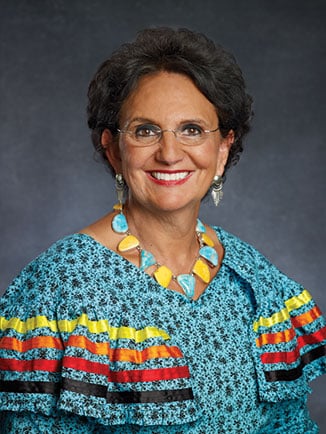
Bozho (Hello),
Margaret Zientek is the director of Workforce Development and Social Services located at 1549 Workforce Drive, Shawnee, OK 74801, which is near the Tribal Administration building. Her department contains several programs including career training, direct employee assistance, education counseling, education assistance and more.
One program that I get a lot of inquiries about is the Legal Aid Services of Oklahoma, Inc. This program would be for those Tribal members residing in Oklahoma. The free legal help organization is contracted by Margaret Zientek’s department to provide legal services to our people. The service does not pertain to all issues. For example, the program cannot provide criminal assistance nor can they represent a person against CPN or another CPN member or employee.
The service categories are
• Family — violence, divorce, paternity, minor and adult guardianships, and child support
• Housing — eviction, landlord/tenant problems, foreclosure, public housing/Section 8
• Consumer — wage and bank account garnishment, debt defense, bankruptcy
• Public Benefit Appeals — social security, veterans, unemployment, SNAP (Supplemental Nutrition Assistance Program)
• Estate Planning — wills, designation of agent, advanced directive for healthcare, transfer on death designations
• Reentry — criminal record, errors/expungements, driver’s license reinstatement, court costs and fines
Who is eligible? CPN contracts with Legal Aid Services of Oklahoma, Inc. (LASO) to provide free legal advice or representation for legal issues within Oklahoma to CPN enrolled members, CPN employees, persons enrolled in a program through CPN Workforce Development and Social Services, and persons with children enrolled in CPN childcare programs.
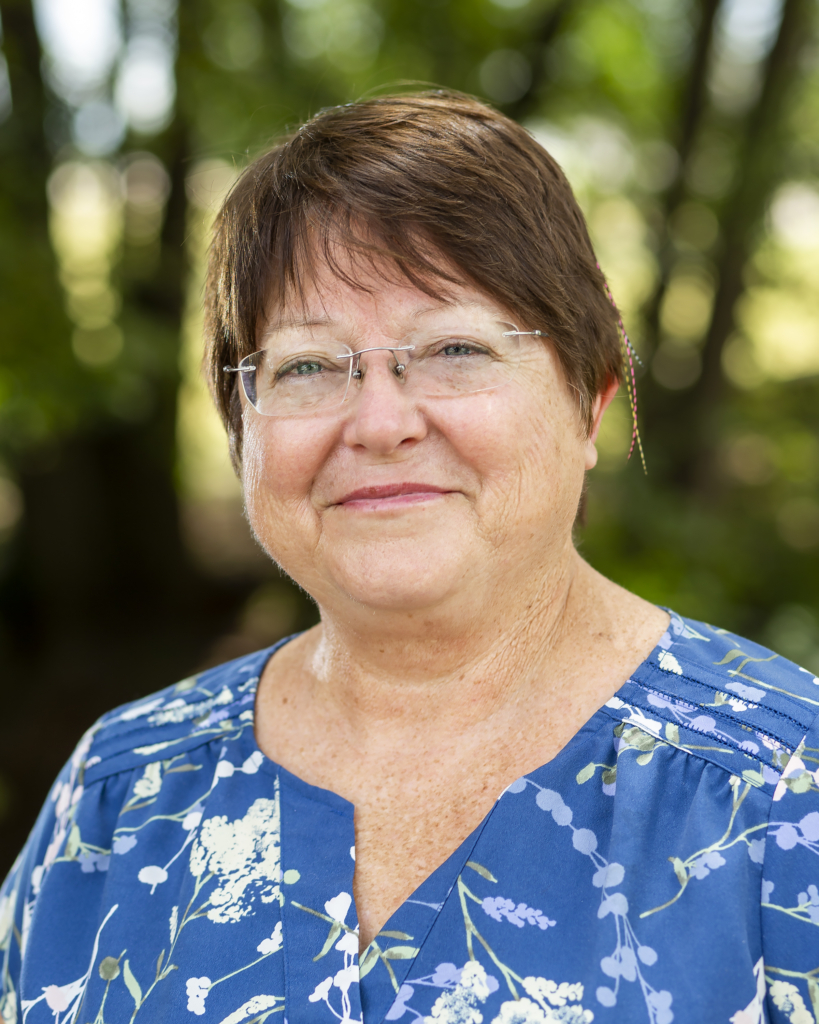
Margaret’s department provides services to Tribal members living in the following Oklahoma counties: Pottawatomie, Lincoln, Payne, Cleveland and Seminole. These Tribal members can call CPN Workforce Development and Social Services at 405-878-3854. Please have your Tribal ID available and ask for Melinda Duin or Brooke Wheeler. Tribal members outside of these five counties would need to contact Brooke Wheeler, Legal Aid Service of Oklahoma, Inc., 316 N. Broadway, Suite C., Shawnee, OK 74801. Brooke’s office number is 405-275-6870. (Direct line: 405-488-6753 | Fax: 405-275-6872 | brooke.wheeler@laok.org)
For our Tribal members living outside of Oklahoma, there is a possibility that there are legal services that you can access under certain circumstances. You can find a wealth of information at usa.gov, which has information about where to find answers to the most requested facts in the United States of America. You can learn about benefits, grants and loans, consumer issues, disability services, disasters and emergencies, education, government agencies and elected officials, health, housing, jobs and unemployment, laws and legal issues, and more. The list goes on with several pages of topics.
My wish is that I have helped someone with this article. I cherish the opportunity to serve as your Vice-Chairman.
Migwetch (Thank you).
My best,
Linda Capps | Segenakwe (Black Bird Woman) | Vice-Chairman
Work: 405-275-3121 | Cell: 405-650-1238 | lcapps@potawatomi.org
Alan Melot
District 1
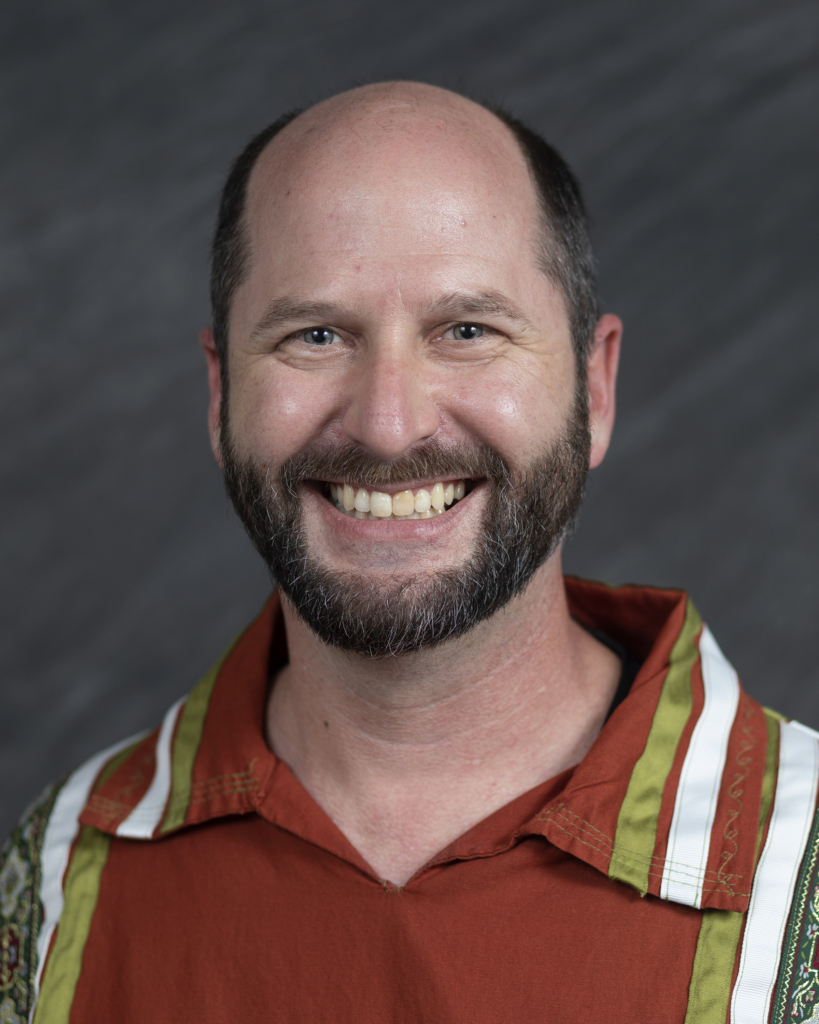
Bozho, jayék (Hello, everyone),
I hope you are making plans to travel to CPN this June for our Family Reunion Festival and powwow. It’ll be here before you know it! I’m looking forward to seeing everyone again. It’s been a while since I’ve been able to get together with y’all.
Do any of you have family drama? CPN can often help, even for those of us who aren’t close. I got a call recently from a D1 resident who was having trouble remotely managing the transition of a family elder from one facility to another in the Shawnee, Oklahoma, area. They were already in contact with our Adult Protective Services (APS) and others in our administration, and I am grateful for the help that our APS provided for the family in my district. APS Director Janet Draper and Case Manager Brian Moore visited with the family to learn what was in the best interests of our elder and worked on effective options for all involved, collaborating with the family to make sure no stone was left unturned. I had the pleasure of visiting with Janet and Brian during the process and came away quite impressed with their knowledge and dedication to our elders. I had the privilege of meeting Janet last year at a district meeting that D4 Legislator Jon Boursaw invited me to co-host, so I already knew the goals behind our APS program. Seeing Janet and Brian in action was a different experience than just hearing Janet talk about it, and I can vouch for these people as being a blessing to our Nation. They helped out with a difficult situation and competently navigated some drama-filled family exchanges with grace and professionalism. I am proud of the work our administration and dedicated employees have done to help CPN citizens with caring programs like CPN Adult Protective Services.
The Trail of Death Caravan planning continues to gather steam. Stops are being planned for Logansport, IN; Lafayette, IN; Homer, IL; Decatur, IL; Springfield, IL (special program by the Illinois State Museum); Berlin, IL; Perry, IL; Quincy, IL; Palmyra, MO; Moberly, MO; DeWitt, MO; and Osawatomie, KS. The cross-country caravan will take place in the third week of September, which I hope will be after the summer heat breaks! Pencil this week in on your calendar as it is a very unique opportunity to honor our heritage of resilience throughout the removal period. I hope to see many of you at different points of the journey.
As always, it is a privilege to be your legislator. Please reach out if you think I can be of assistance or you just want to talk. Keep me and my family in your prayers as I keep you and yours in mine.
Bama pi (Until later),
Alan Melot | Legislator, District 1 | alan.melot@potawatomi.org | 608 S. Sergeant | Joplin, MO 64801 | 417-312-3307
Eva Marie Carney
District 2
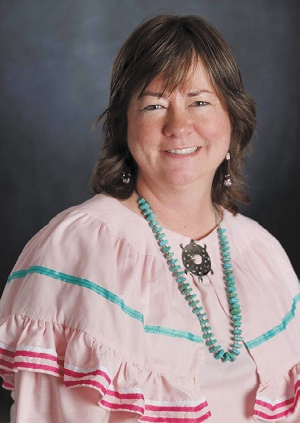
Bozho, nikanek (Hello, friends),
Mdamen Leadership Program
I hope most readers know about our Mdamen program. Mdamen is modeled after our Potawatomi Leadership Program that is geared toward college-aged Tribal members who are exploring their heritage. Tribal members asked if a similar program could be created for them after seeing the PLP’s success, and Mdamen was launched in the fall of 2021. The virtual format allows 20 Tribal members 18 and older, after selection by an independent committee, to learn more about their Potawatomi roots, even if they are unable to travel to CPN headquarters.
The six-week program wrapped up toward the end of February with a reflections session. I regret that I was not able to participate in the session in real time due to a scheduling conflict, but I viewed the recording and was mightily impressed and touched by the participants’ varied reflections on their experiences. CPN Department of Education staff Kym Coe and Tesia Zientek poured a lot of their time and talent into making the program a success — migwetch (thank you) to you both! The application window for the 2024 Mdamen class will open later this fall — look for the announcement in the Hownikan, on social media and on potawatomi.org. I’ll share the announcement via email and social media, too.
Tribal enrollment news
Our quarterly Legislative meeting took place on Feb. 23. We voted to enroll 193 new Tribal members, including several infants born in late 2022 and early 2023. That means that the Tribal Rolls Department has wrestled down the application backlog, which
was no small feat, and is now reviewing applications as they are received. Migwetch for the hard work, Chuck Clark and team!
Future District 2 meetings
We will have our Fall Feast in Arlington, Virginia, in November. I hope to host a meeting in the Nashville, Tennessee area before then and likely will plan a meeting somewhere on the east coast of Florida in early 2024. I just saw that the National Zoo Bird House in Washington, D.C., reopened in mid-March. I read that it has been transformed into a habitat for North American shorebirds, waterfowl and songbirds with an observatory where you can learn about how Smithsonian Migratory Bird Center Staff tracks the movements of wild birds. I’ll be looking into options for a group tour and get the word out if that’s a possibility.
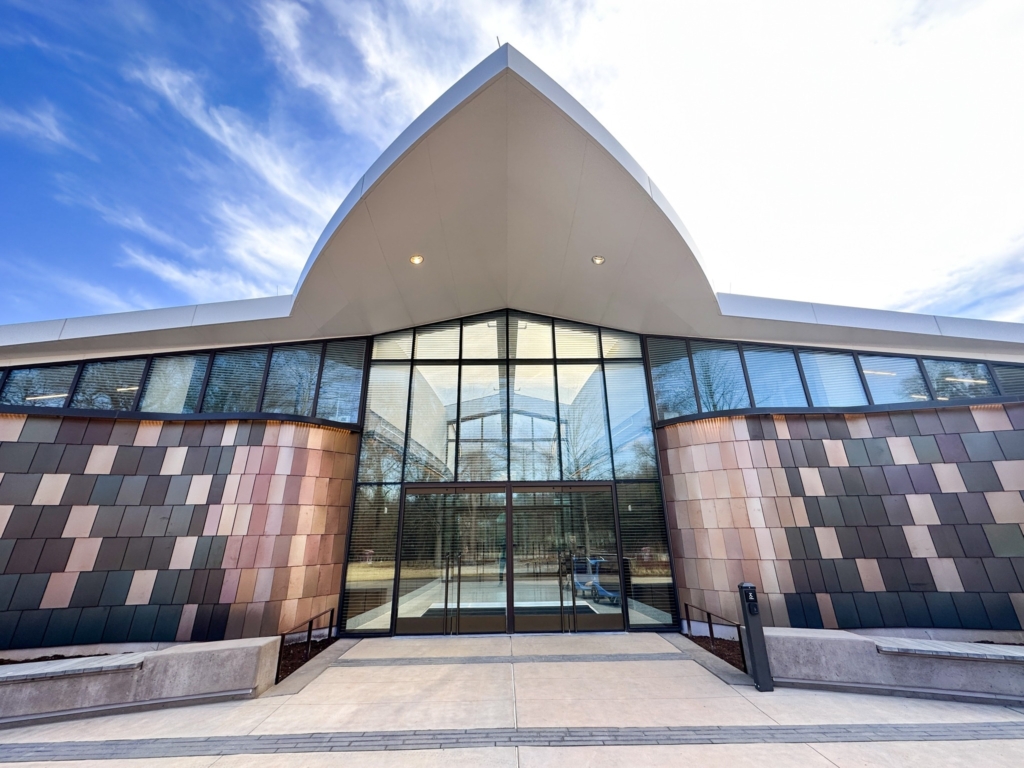
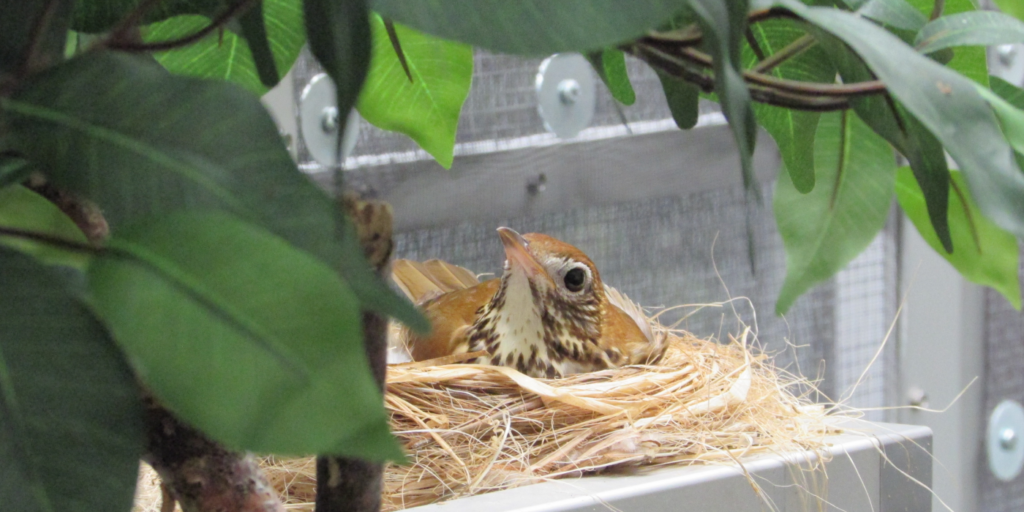
Please send me a note if you want to be added to my group email list to stay updated on District 2 events. And if you are a Facebook user, please send me a Facebook message asking to be added to our private D2 Facebook group, which currently has about 270 members.
See you this summer?
I hope to see many of you this summer for our Family Reunion Festival taking place Friday, June 23 through Sunday, June 25, and/or the 2023 Potawatomi Gathering, hosted by the Nottawaseppi Huron Band of the Potawatomi on the Pine Creek Indian Reservation near Fulton, Michigan, from Monday, July 24 through Saturday, July 29. The first part of the Gathering week will be a Language Conference. Craft instruction, morning ceremonies, dancing and more start Thursday. You can sign up for Gathering updates via an email subscription box that pops up when you visit the Nottawaseppi website, nhbp-nsn.gov. All these dates and details are on my website calendar.
Loss of our matriarch
My dear aunt and godmother, Agnes Wood Barron, walked on Feb. 7, 2023, at the age of 96. She was so kind and welcoming to all her family members and nieces and nephews. Her daughters hosted a 95th birthday party for her last year, and I’ve included a photo taken that day of Aunt Aggie and three of her godchildren. May her memory be a blessing. I extend condolences to all our family for this loss.
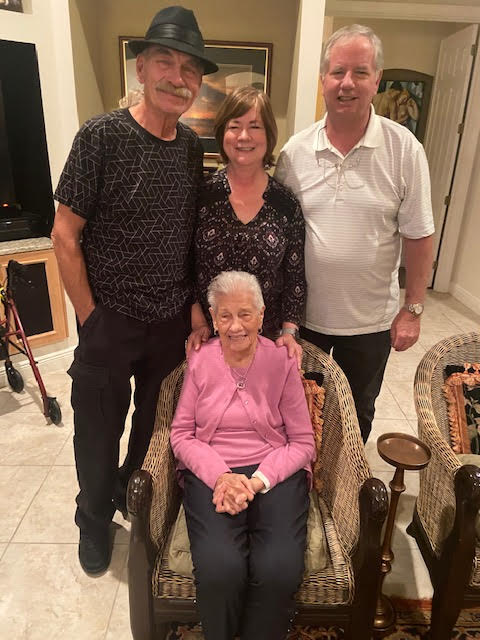
godchildren Bobby Whitell, David Lawless and Eva Marie Carney
It’s an honor to serve as your representative.
Kind regards and bama mine (until later),
Eva Marie Carney | Ojindiskwe (Bluebird woman) | ecarney@potawatomi.org | evamariecarney.com evamariecarney@gmail.com | 5877 Washington Blvd. | PO Box 5591 | Arlington, VA 22205 | Toll Free: 866-961-6988
Bob Whistler
District 3
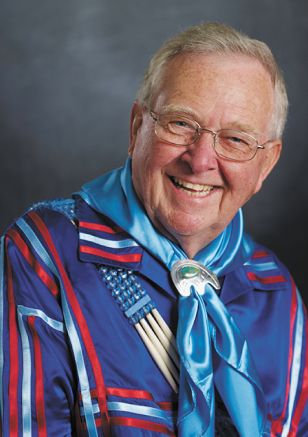
Bozho, nikanek (Hello, friends),
Hope Squad
I recently read that 1 in 3 of our children in grades 7 through 12 may be struggling with mental health issues in more than 30 states. Also, 1 in 4 feel depressed, sad or hopeless most of the time. Moreover, 1 in 10 contemplate suicide. As adults, we don’t realize that due to advancement in technology, social change and consolidation of smaller schools into larger central facilities that our children face a to-tally different environment and challenges than we did at their age. The factors that affect them today include social isolation, comparison, family issues, social media, technology, academic pressure, social pressure and the pressure to be perfect.
The program Hope Squad assists schools to help our children. It is already in 43 states. Ironically, when your child has issues in the above areas, in most cases, they will never tell you but suffer. However, they do talk to their peers. Additionally, since their student peers are faced with some of the same threats, they will recognize early signs of jeopardy and suicidality.
The Hope Squad in each school consists of trained staff along with trained and trusted elected students that your child may go to when they are the victim of a bully or are undergoing forms of mental stress.
I am asking that each of our Potawatomi parents with children in elementary, middle and high school look into having their school create a Hope Squad program if one is not already there. Yes, there is a cost for the training, etc. It will run from $1,400 to $3,200 for the first three to four years and then about $500 per year thereafter. We all pay state and local taxes. Some of that tax goes into the education system, and each school has a budget. When you look at the cost, ask yourself… Is my child worth the school spending possibly a one-time cost of $10,000 overall to protect them and the other several thousand children that attend their school each year now and in the future? While I have talked about grades 7 through 12, I suggest that you start going to your PTA in the lower level and have them approach your principal to get the program at your child’s school.
For starters, go to hopesquad.com, click on the “Contact” link, then drill down to “Request information” and complete the form. For Texas schools, you may contact Dr. Jennifer Roberts at jennifer@hopesquad.com if you have any challenges or questions.
Iron Horse Industrial Park
While in Shawnee for our March 2 legislative meeting, I had the opportunity to visit Iron Horse Industrial Park and tour our new pipe manufacturing facility. While there, I saw our new locomotive to move the rail cars on our rail line for transportation of the finished product. A photo of the locomotive and Chairman Barrett is attached.
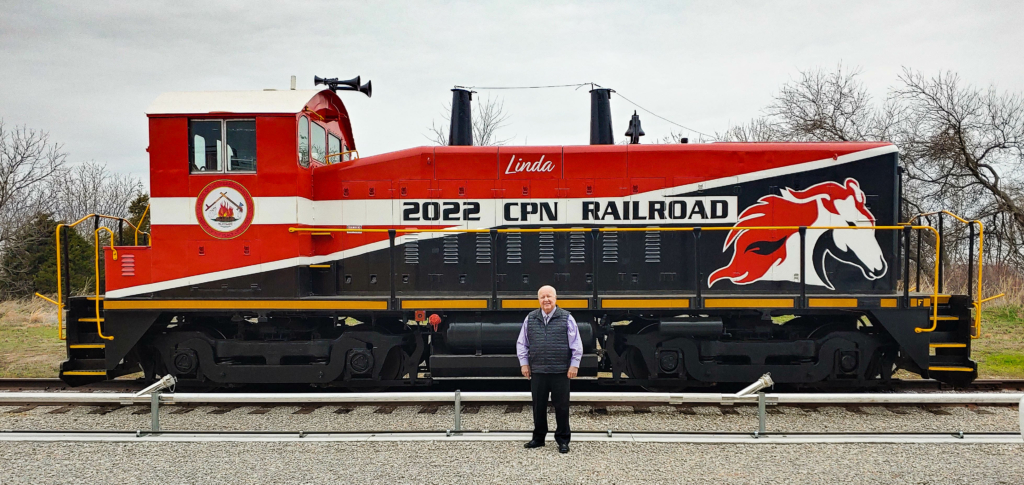
Columbarium
In our 2022-23 budget, funding was included to build a columbarium for CPN cremated remains. The initial site being built will have 400 niches to be delivered in July to hold containers for two sets of ashes. Attached is a photo of the preliminary foundation area by our church on S. Gordon Cooper Drive. You will be able to see the near completed site at the Family Reunion Festival this year.
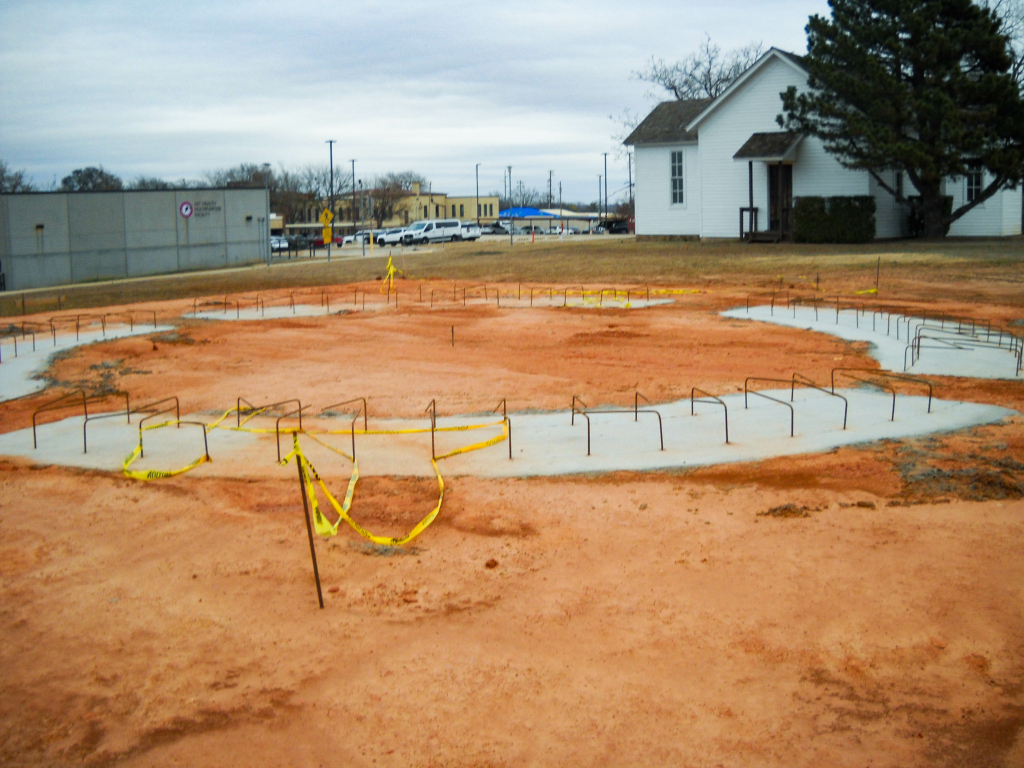
I thank you for the honor of serving you and am honored that you have elected me as your District 3 legislator. I am your voice to staff for any questions you may have on benefits or services. Simply email or call me.
Nagech (Later),
Bob Whistler | Bmashi (He Soars) | rwhistler@potawatomi.org | cpn3legislator@yahoo.com | 1516 Wimberly Ct. | Bedford, TX 76021 | 817-229-6271 | cpndistrict3.com
Jon Boursaw
District 4
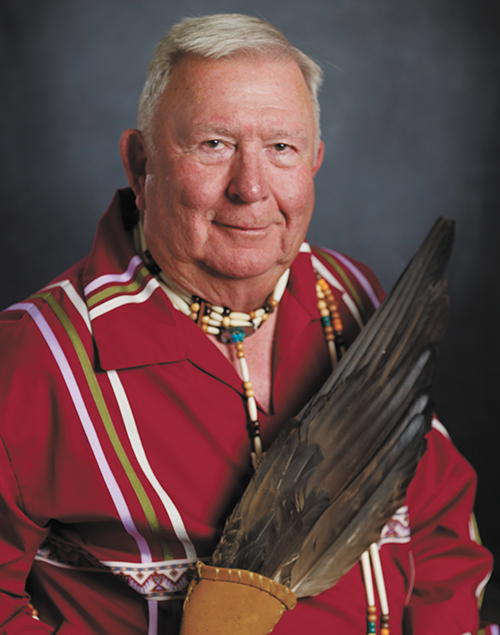
Bozho (Hello),
Naming Ceremonies
The aspect of being a CPN Legislator that I enjoy most is being asked to give a Tribal member their Potawatomi name. I have sincerely enjoyed performing this ceremony for the past 12 years. In most cases, I have shared the various phases of giving someone their Potawatomi name with my brother, Lyman. We think combined we have named well over 150 Tribal members. Although most of our namings have been in the Prayer Circle on the grounds of the CPN Community Center in Rossville, Kansas, we have performed namings at a variety of locations and surroundings, including the Lawrence Community Center where we named 26 members of one family; a beautiful pond in the sand dunes south of Holcomb, Kansas; the Prayer Circle in Shawnee, Oklahoma, during the Family Reunion Festival; the Mid-America All-Indian Center in Wichita; and Tribal members’ own backyards.
Performing the naming ceremony and the location is only half the process. The other half involves creating a name that is unique and specific for the recipient. Lyman and I share this, too. We use the same list of standard questions that gives us a little background on the individual. We also ask them for the name and contact information of someone who knows them the best. This can be a spouse, parent, sibling or a best friend. We then discuss our suggestions until we agree on what fits best.
The best part of the whole process, and the briefest, is telling the individual the name created for them. We can recognize whether we were successful in picking their names by the expression on their faces and especially their eyes. On a few occasions, we have had to render assistance to those overcome with emotion. We announce the name in Potawatomi. We obtain the name and pronunciation in Potawatomi from Justin Neely, the Director of the CPN Language Department.
Lyman and I recently held a naming ceremony east of Valley Falls, Kansas, in the farmyard of one of our Boursaw/Ogee cousins. The four individuals named that morning were:
Kassondra Christensen | Jakmzhenatkwe | Woman who captures life
Carson McAfee | Wesi-kenonat | He talks to the animals
Michael Ice | Ndo-nado’at | One who seeks to heal
Justin Ice | Nashabjeget | Man who sees things twice
I recently asked a young Tribal member what it meant to have received her Potawatomi name:
“Several years ago, I was given the name Niba Gishek Kanabdek (Night Sky Watcher) at a Potawatomi naming ceremony. It was a special moment in my life as I was surrounded by my family and other Tribal members. I felt as if I was part of something bigger than myself. Being Potawatomi was a part of my life that I had always wondered about, and this ceremony felt like the first step in establishing myself as a Tribal member. It helped me feel a deeper connection to my father and grandfather and is something I hope to pass down to my future children.”
Upcoming CPN Elders’ Potlucks
The dates for the next two Elder Potlucks held in CPN Community Center in Rossville at noon are:
April 14 | Italian, with garlic bread | RSVP by the 11th
May 12 | Fried chicken | RSVP by the 9th
Come join us and bring your favorite side dish or dessert. If you plan to attend, please RSVP to Tracy or Brenda at 785-584-6171.
It is an honor to serve as your legislator.
Megwetch (Thank you),
Jon Boursaw | Wetase Mkoh (Brave Bear) | jon.boursaw@potawatomi.org | 2007 SW Gage Blvd. | Topeka, KS 66604 | 785-608-1982 | Office Hours: Tuesday 9-11 a.m. | Thursdays 3-5 p.m. | Other times as requested
Gene Lambert
District 5
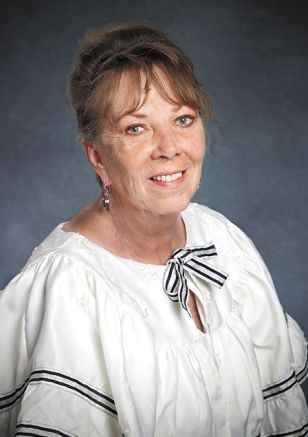
Bozho (Hello),
We all know or are at least aware of the growth, advancement and achievements of our Native American people.
You can look around and see the influence we have cast on the profile of the American public through the arts, ways of life and public use of our languages tacked onto streets, sports teams, buildings, etc. Our own Sharon Hoogstraten has a book out called Dancing for Our Tribe, which is a beautiful capture of Potawatomi regalia and CPN members. You could purchase the book at cpn.news/DFOT and see the talent and love
this lady gathered over years of photographing Potawatomi people.
We now have a rising star, Legislator Paul Schmidlkofer, who has been working with a movie production company in Oklahoma on a movie called A Thousand Tomorrows. You can find a trailer online. It is my understanding this isn’t the first or last. Break a leg, Paul.
Music is another influence captured by the drums touching us all throughout the ages. The beat of the heart. When I go to CPN gatherings, the drum is the first thing I hear to know I am home.
We all have a preference to the type of music we are comfortable hearing. There is a rhythm in each of us. Every generation has their own music and new ideas, including our Native people. It is impressive to see the past and present talents we encompass with Indigenous people.
I wasn’t aware we have an Indigenous Hall of Fame. Amazing as you take a look at massive talents of people you didn’t even know were Native. One that caught my eye first and is said to be the most famous was Redbone from Los Angeles, California. You may not be aware of the band, but you might remember the song “Come and Get Your Love.” I know the words by heart but was never aware they are our people. They started together as a band in 1969 and became famous in the 1970s.
Frank Waln is another award-winning Sicangu Lakota Native from the Rosebud Reservation in South Dakota. He has won awards and grants, including three Native American Music Awards and the 3Arts Awards grant for Chicago artists in 2016.
We cannot forget Weda Skirts, which has one member of Potawatomi heritage and released their first album Many Moons in 2016. Elexa Dawson, a descendant of Edith Martin Roberts, is the lead vocalist/songwriter. I have heard them perform, and they are a great folk band well worth your time to check out.
The movie Avatar was based admittedly on Native Americans. They made references often on the bloodshed between the military and Indigenous people. The movie itself brought in over $1 billion in revenue, but from everything I read, there are some who fell in love with the movie and others who resented the reference. I thought it was beautifully done. It was the first time I saw anything in 3D since I was 10.
The song Black or White by Michael Jackson utilized Native American dancers in the video. It was not obvious to me in the past that Jackson was tuned in to our Native people.
There isn’t any possible way to acknowledge all the talent out there, and hopefully, I have not offended anyone as they were not mentioned. I encourage you to take the time and realize the impact our people have had, inspired and created for the world to see.
We truly have made this a better world.
Keep making a difference!
Migwetch (Thank you),
Gene Lambert (Eunice Imogene Lambert) | Butterfly Woman | glambert@potawatomi.org | 270 E Hunt Highway Ste 229 | San Tan Valley, AZ 85143 | Cell: 480-228-6569 | Office: 480-668-0509
Rande K. Payne
District 6
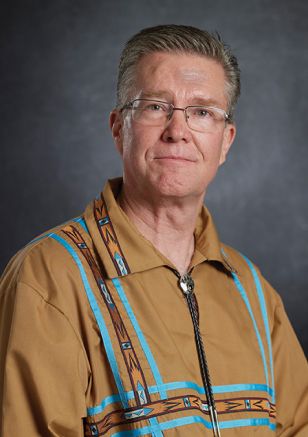
Bozho, Nikanek (Hello, friends),
I can’t help but chuckle at God’s sense of humor. This was supposed to be another cold and dry winter, according to all the experts. Oops! Storm after storm. Flooding. Record snowfall. If you’ve been in Tulare County lately, you’ve probably seen the pray
for rain signs. I know a lot of people have been doing just that, even when it seemed like it would never rain again in California. Yet, here it is; the answer to our prayers for rain. Thank you, Lord! Maybe the One who created it all is still in control of it!
Picking up where I left off last month, I want to talk more about criminal justice reform. Let’s go back 20 years to the passage of Proposition 36, the Substance Abuse and Crime Reduction Act. The law watered down consequences for non-violent drug crimes with probation and drug treatment programs instead of jail time. However, unless a person has a large quantity with intent to sell, it’s a citation for possession of a small amount of just about any drug. I think the idea was that as long as you’re not hurting anyone else by using drugs, you shouldn’t have to go to jail.
So 20 years later, we have a homeless population explosion. There are a wide range of reasons for homelessness, but from what I’ve heard and seen, the largest segment of this population is in some type of drug addiction. Because of their addiction, they are unable to function in society. Many are suffering from mental illness from prolonged drug abuse. But they’re not hurting anyone else, right? But what about the people I wrote about last month who make their living selling drugs? They kill each other over territory. The illegal drug trade is big business in California and lethal in so many ways. If California is going to get serious about the homelessness crisis and gang violence crisis, it has to start with dealing with the drug problem. Over time, Proposition 36 has proven to be detrimental to the lives and safety of our citizens. It says, “Drug offenses are not classified by law as violent or serious offenses.” I disagree. I believe that God gives every human being a talent and will someday hold us accountable for its use. Life is a terrible thing to waste.
On a much brighter note, I recently suffered through one of the worst sinus infections I’ve had in a long time, and it got to the point where I knew I needed to see a doctor. I knew it would be difficult to try to get into my regular doctor, and I didn’t want to go to an urgent care clinic. So, I got on my AllyHealth app for the first time since setting it up last year. Within a few minutes, I talked to a doctor and described my symptoms and history with sinus infections. The doctor prescribed a Z-Pack antibiotic treatment, and 30 minutes later, I was at Walmart picking it up. I can’t tell you how fast and easy it was. I strongly encourage you to get set up. It’s free for you and your family. I rarely get sick and thought I would never use it, but I’m so glad it’s available to CPN members. Learn more at cpn.news/CPNcare.
Wisdom from the Word: “Aaron and his sons will go in and appoint each man to his service and his responsibility.” (Numbers 4:19)
Migwetch, bama pi, (Thank you, until later),
Rande K. Payne | Mnedo Gabo | rande.payne@potawatomi.org | 31150 Road 180 | Visalia, CA 93292-9585 | 559-999-5411
Mark Johnson
District 7
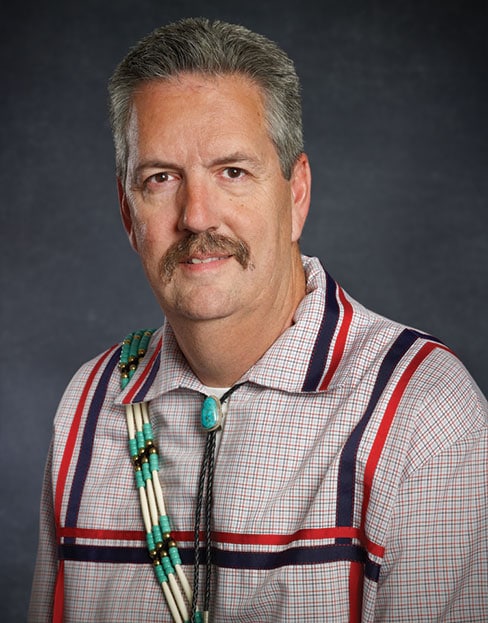
Bozho, nikanek (Hello, friends),
California and the remainder of District 7 has seen a record-breaking winter as far as snowfall and rain goes. I think the terminology used is “once in a generation” event. This is something that I can attest to, having fed my cattle in a blizzard the other day — a blizzard, in California — and I only live at 900 ft. elevation. Mother Earth is taking a long cool drink and healing herself from the last few years of drought and heat here in the West. And with all that moisture, the grass crop growing in the foothill and mountain areas of the West will be very heavy this year also. As a reminder for our families living in the mountain and foothill areas of District 7, it won’t be long before the heat returns and dries out all the new vegetation. Make sure you have your 100 ft. clearance around your home, if not more. Wildfire will return to the West again this summer as it does every year. You do not want your home to become another statistic.
Have you made your travel arrangements for the Family Reunion Festival in Shawnee from June 23 through the 25? Like I said last month, the 2023 Honored Families will be Johnson, Lafromboise, Lareau, LeClaire, Melott, Rhodd, Tescier, Weld and Young. If you have never been, you need to add this to your bucket list and come join us, and like I said, it is never too soon to secure rooms and travel for your trip to Shawnee.
If you haven’t taken the time yet, sign up now for CPN Care. This benefit is available to you and your family, including non-Native children under 18 years old living with you and non-Native spouses. It will take two to three days for your account to become active, so sign up now before you need it at 2 a.m. It is no cost to you and your family to join or use. Besides being able to talk to a doctor 24/7/365 for general telemedicine, life assistance and pharmacy discount services, sign up, even if you have good insurance. It may come in handy in the middle of the night when your regular doctor is not available. I had the opportunity to use this a couple of months ago when my doctor was on vacation. It was quick and easy — and professional. Find out more at cpn.news/cpncare.
Once again, I would like to say what an honor it is to serve you as your District 7 Legislator. As always give me a call, and I will be happy to work with you on any questions you may have or provide you with additional information you may need to access Tribal benefits available to you. Please also take the time to give me a call or send me an email with your contact information so that I can keep you informed of the happenings within the Nation and district.
Migwetch (Thank you),
Mark Johnson | Wisk Mtek (Strong as a Tree) | 559-351-0078 | mark.johnson@potawatomi.org
Dave Carney
District 8
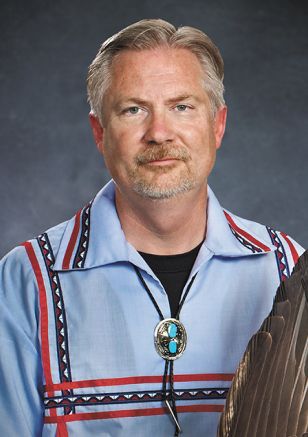
Bozho, nikan (Hello, friend),
I hope this edition of the Hownikan finds all in District 8 healthy and doing well.
As winter wraps up and spring does its amazing work, I would like to mention an event that Justin Neely and the Language Department hosted in mid-February — Winter Storytelling. The event was live at the Nation’s Cultural Heritage Center and available on Zoom to all. Attendance was good, and the stories were well received. Traditional favorite stories included why the vulture looks the way he does, why raccoons have black eyes and why there is day and night. I have posted a collection of winter stories as compiled by my sister, Eva Marie Carney, on the District 8 Facebook page. According to the cultural teachings of the department, certain stories should only be told when the earth is sleeping in the winter months — so please be respectful of this.
I am planning on a cookout for area Potawatomi on Saturday, Aug. 5, in the Lacey/Olympia area. I hope as many members as possible can attend and enjoy summertime classics like hamburgers and hot dogs. Usually, the Nation supplies the main course, and we ask that attendees bring desserts if they wish to. Look for a postcard in your mail and other online notifications.
Whenever I host an event with food (which is pretty much all events), I have an idea of having some traditional Native foods. One side dish that I hope to have at the cookout (at least for folks to try) is wild rice.
Most scholars believe that Potawatomi began eating wild rice about a thousand years ago as they settled around the Great Lakes area. They called it mnomen, which means “the good seed.” They saw it as a gift from the Creator. This food became a staple to the people for many reasons, one being that it can be stored and eaten over several seasons.
The Seven Fires Prophecy tells the story of how Potawatomi eventually stopped in the Great Lakes region. One of the prophets told the Potawatomi to settle where they found “the food that grows on water.”
Gathering the “food that grows on the water” was pretty much a family affair — with everyone participating.
Several years ago, I purchased a generous amount of wild rice for a District 8 meeting. We cooked some and distributed more to attendees. It had a unique flavor. If you’d like to try some, go to bineshiiwildrice.store. This rice is gathered in canoes and hand harvested as it was hundreds of years ago.
I am looking forward to seeing Potawatomi family in Oklahoma and at district meetings in 2023.
Don’t forget that the Family Reunion Festival and powwow is from June 23 through 25.
It is my honor to serve as your legislator,
Dave Carney | Kagashgi (Raven) | dcarney@potawatomi.org
520 Lilly Road, Building 1 | Olympia, WA 98506 | 360-259-4027
Paul Wesselhöft
District 9
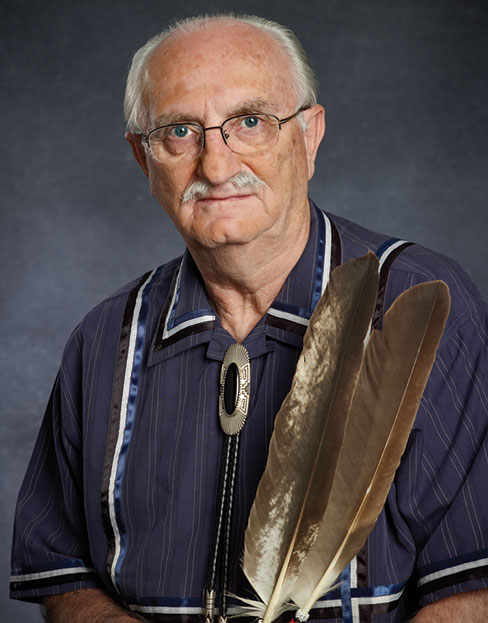
Bozho, nikan (Hello, friend),
Walked on
I’m a poet. Poets search for meaning in everything. It’s an occupational hazard. I’m struck by the Potawatomi phrase “walked on.” Many of my friends and relatives have walked on. I miss them dearly.
When we say someone has walked on, I believe we are saying that this person once walked with us, walked side by side with us, sometimes walked hand in hand with us. For me, the metaphor means that this person we loved is still walking and has walked on ahead of us on a spiritual path unlike the terrestrial path we are presently on.
My faith teaches me that the created soul and the magnificent human brain is unique and too developed, too important, too cherished, to be annihilated. I can’t accept annihilation, which is the complete extinction of someone. Annihilation signifies that this person will never exist again. I believe in an eternal state of existence unlike the existence we experience in this life. When my loved ones walk on, they “walk” into an existence created by God, and someday I will walk with them again.
A very good friend of mine lost his young, beautiful daughter to an untimely death. She walked on without him. I wrote a poem to comfort him and to honor his daughter, Charity. Edgar Allen Poe wrote, “The death of a beautiful woman is, unques-tionably, the most poetical topic in the world.” I agree with the Bard. My friend has allowed me to share my poem with you.
Untimely Death
By Paul Chrisstarlon Wesselhöft
The untimely death
Of a young beautiful woman
Ruptures the heart, numbs the soul.
Life is unsettling, never whole.
Such a death,
Lamented by lover, father, mother,
Is not diminished with days, years.
Tears dry but drop again.
The love and communion
Of her never ends.
The face, voice of her,
Time transcends.
The sole thing that makes a soul whole
Is a longing for reunion.
Migwetch (Thank you),
Paul Wesselhöft | Naganit (Leader) | reppaul@gmail.com | pwesselhoft@potawatomi.org
David Barrett
District 10
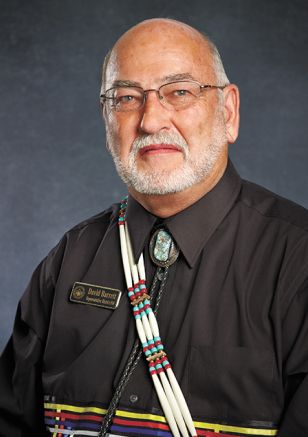
Bozho (Hello),
Sacrifices that our soldiers have made while serving our country should be remembered. With very few exceptions, the men and women who serve our country, whether in peace time or war, make sacrifices — family separations, often isolated tours of duty, long and difficult hours with no extra pay. They serve you and me through their efforts, often in dangerous circumstances.
The military families also make sacrifices from the stress of war, multiple deployments and frequent moves that can affect the wellness of military families. Children and spouses can experience anxiety, changes in relationships with family and friends, isolation, or emotional challenges in dealing with deployments, illness or injury, and high mobility.
Being a soldier is not easy; in fact, it is one of the most challenging things to do. Their lives are full of hardships and challenges that no ordinary person can survive.
Memorial Day marks the traditional beginning of the summer vacation season. The three-day weekend involves picnics and barbecues and family trips, but it is also about acknowledging the debt Americans owe those who died to protect our country. There is this one, special day each year called Memorial Day, and that is the day to remember the fallen and those who have made the ultimate sacrifice. Since the country was founded, well over 1 million Americans have died in the nation’s wars.
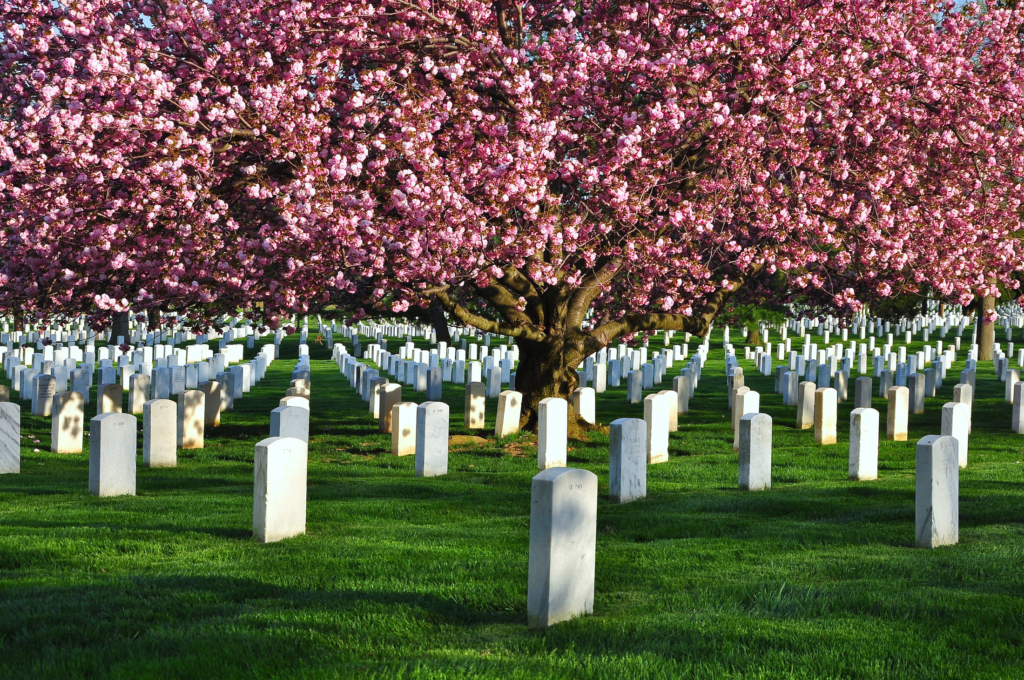
Memorial Day grew out of the carnage of the Civil War. So did Arlington National Cemetery, which was created in 1864 to bury those killed in the Civil War’s Overland Campaign.
Allow me to summarize something to remember during this time from an article written by Rachel Engel on May 26, 2017, for Police1 about the five things not to do on Memorial Day.
- Don’t wish anyone a “Happy Memorial Day”
- Don’t thank the current troops
- Don’t disregard its importance
- Don’t forget it exists
- Don’t let politics keep you from rendering respect
Despite what this day has transitioned to in American culture, it was established to honor and remember America’s fallen. At least, don’t thank a veteran on Memorial Day
just because it’s Memorial Day. They deserve respect and gratitude every day of the year, but this day is set aside specifically for America’s fallen warriors from every war.
America’s veterans are honored during November on Veteran’s Day when we aim to remember and appreciate the sacrifices of all veterans. But, Memorial Day allows the country to focus on those service members who are no longer with us — an important distinction.
In this day and time with our society going in the wrong direction, we also need to show
the same respect to our men and women in blue, who need our support.
Take time to thank a veteran, first responder and a person in blue when you have an opportunity.
It goes without saying that it is both a pleasure and an honor to serve you and our great Nation.
Migwetch (Thank you),
David Barrett | Mnedobe (Sits with the Spirits) | dbarrett@potawatomi.org
1601 S. Gordon Cooper Dr. | Shawnee, OK 74801 | 405-275-3121
Andrew Walters
District 11
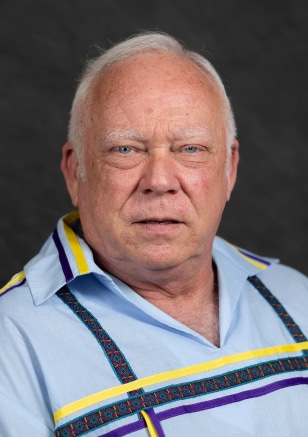
Bozho (Hello),
By the time y’all read this, the storms of late February here in Oklahoma will be a thing of the past. Those storms came out of the west with a vengeance and descended on Oklahoma with reported wind speeds of over 100 miles an hour, rain and tornados. The tornados, 12 of them identified, ranged from EF-1 to EF-3. The one closest to Shawnee was the strongest.
It was in late evening when the wind came up from a remarkable calm. The air seemed heavy, and things were quiet and still. Only the sound of faraway thunder broke the
peace. February is a rare month for tornados here. I believe that the previous record
was two in one day, so this group far broke the previous records. Here in Oklahoma,
I have found few things catch our attention more than weather. Despite some beliefs, we get quite hot in the summer, at times over 110 degrees. And the winters can be bitter. Last year, we had a long run of below 0 weather, and in 2000, the weather was brutal with -17 degree temperatures over a large part of the state. It is, in part, those huge temperature variations that contribute to the formation of the supercell storms that birth tornadic activity. Simply put, when cold air from the Rocky Mountains mixes with the warm air of the Gulf of Mexico, huge storms form. These normally form over Oklahoma, Kansas and northern Texas in spring.
On Feb. 26, the conditions were right for these storms to form. They popped up in western Oklahoma first, and the line moved through OKC and into Shawnee heading east. The storms in the OKC area caused some damage, but by far the one that came through the Shawnee area was the most dangerous. Weather warnings popped up on the TV, and the threat of tornados quickly overcame all else in importance. As the storms birthed tornados around Norman, they moved through that area, causing some damage to homes, power lines, metal buildings and trailers. The storms moved northeast from there, coming through the communities of Pink, Little Axe and Bethel Acres and crossed I-40.
Those of you that know this area know that the Grand Casino Hotel & Resort complex is in that area. Reports started reflecting that a tornado was at the Grand Casino, moving northeast through Dale and McLoud toward Meeker. Tim Zientek, the hero of my story and the Tribe’s emergency management coordinator, was already en route to the casino. Through the Chairman’s forethought, the casino built a large, 5,000-person storm shelter situated in its event center. Some 20 minutes before the arrival of the storm, sirens were sounded and the building secured. The storm came close… in-the-parking-lot close… but missed the Grand and the CPN Health Services West Clinic. The storm continued for some miles, finally lifting north of Shawnee but not before destroying some homes and property here.
Having worked emergency management in my pre-retirement life as well as three major hurricanes on the Gulf Coast, countless floods and man-made incidents, I know what it takes to assure life and property in conditions like these. I must commend Tim Zientek, his emergency management crew and the Tribal Police for their work that night. When conditions are such that most people are running away and hunkering down, it takes incredibly special people to stand up and run into the maelstrom. By courage, planning and practice, this was just an incident and not a disaster. By foreword thinking in construction and management, people were kept safe. Migwetch… my friends. Y’all are heroes.
Bama pi (Until later),
Andrew Walters | andrew.walters@potawatomi.org | nibwemko@gmail.com
